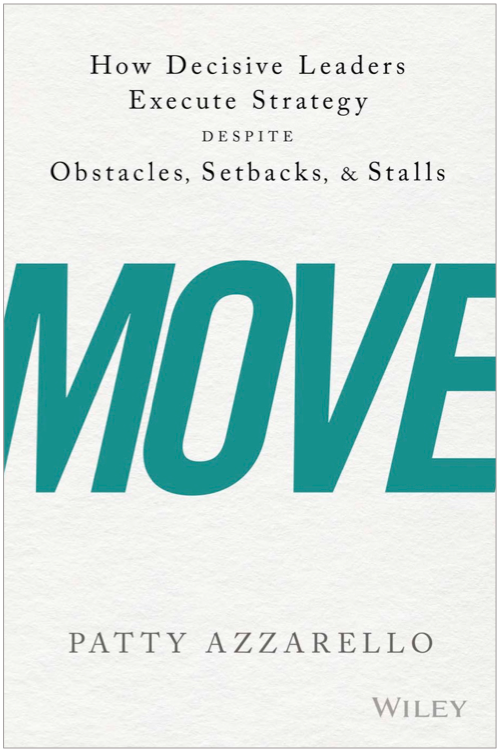The problem
For years I have been trying to figure out why so many leaders tolerate poor execution and do nothing about it.
One unfortunate issue I see quite regularly is simply that some “big” executives seem to believe that execution is beneath them.
They view execution as a low level job for other, less important, less strategic people to deal with.
Above it all
This “above it all” approach is dangerous.
When your involvement stops with the vision and the talking part, your organization can not possibly automatically self optimize to make your strategy happen.
Strategy must have action.
Strategy without Action is just nice, big-sounding words about things you hope will come true.
And action does not happen without executive involvement. Period.
Yet I see so many executives who keep their involvement in strategy at the big, exciting goal level.
It’s as though they believe that people throughout the organization will suddenly understand what new work they have to do, that resources will be automatically re-assigned without any pain, and individuals will understand how to prioritize new tasks over current work, so it will just get done.
Managing execution is not micromanaging
Here are 4 key areas executives need to engage in to make sure their organizations are executing.
None of these are micro-managing, but they are required management work for an executive who needs their organization to move forward on a new strategy.
1. Help the team disengage from current work and current thinking
All organizations are fully busy and under-resourced doing stuff today.
The focus and effort it takes to get people to do different stuff is enormous. This will never happen automatically, or in the background, or with a suggestion.
People will never start doing new things unless there is a clear strategy AND action plan to implement that strategy.
It doesn’t matter how inspiring your big sounding goals are, people will never start doing new things unless the leader actively engages about what to STOP doing (and/or gives them permission to stop doing it). And if required, the executive must be directive about what to START doing, and why.
2. Work through productive conflict
Action causes conflict. The only thing that makes strategy ultimately clear is actually doing it. Strategy is where you put your resources.
You can say your strategy is anything you want, but if you really want to see what your strategy actually is, just look at your budget. Your budget describes what you are doing.
If you want to change your strategy, you need to change your budget.
A good strategy that drives action will require that some things will get more money and some things will get less money. Some people win and some people lose. This causes conflict.
As a leader you will never drive strategy into action if you are unwilling to engage in this level of clarity and conflict. Your team will never sort it out amongst themselves. (This is hard, but necessary.)
3. Execution requires steady communication from the top
As a leader you need to let people know you are serious.
Because you need people to be doing different things and because this causes conflict, people will race back to doing things the old way as soon as there is a bump in the road. So as an executive you need to be very committed to provide an even more powerful, consistent message to stay the course.
You need to over-communicate the strategy by talking about the action: specifically what needs to be different and why.
If your people don’t hear a consistent message about execution from you regularly, over time, they will think “I guess we’re not doing this any more”, forward action will stall, and your team will revert back to the old way.
4. Execution requires measures and consequences
So many companies set strategic goals, then don’t achieve them, and then nothing happens. Without measures and consequences for not meeting goals, no strategic initiative will ever happen.
If the leader does not engage in the discussion about what happened, how will we fix it, and what the consequences are, there is no motivation whatsoever for anyone to do anything different than what they are doing today.
Stay on top of the hard and boring stuff
Being clear and consistent about milestones, measures, accountability, and communicating and following up is hard and boring. But necessary! This is how you you turn strategy and hoped-for outcomes into actually results.
Visionary Executives
Let’s face it. Some executives are not good at this part of execution and will never be.
In this case it is critical for the executive who is an externally focused, industry visionary, deal maker to recognize that they need to choose the right person to manage execution on their behalf.
But take some care to realize that while you can delegate execution to some extent, you can not abdicate it entirely.
Even if you are not personally good at managing execution, you can’t simply remain above it because you find it dis-tasteful, boring, or unbecoming of an executive of your stature.
em>You need to lead the communications, decisions and enforcement of consequences even if you are not doing all the leg-work personally. Otherwise you will be disconnected from the actual strategy of the company as you relish in the big, goal-oriented words that describe your wishes, not your reality.
Moving forward
If you are not happy with how fast and predictably your organization can execute on your goals and commitments, check yourself on this list of 4 things and give yourself an honest grade. Improving your consistency and communications in these 4 areas will allow you to drive more consistent execution in your team.
Want some help with this?
If you’d like to do a kick-off meeting to get your team aligned and focused for the new year, or ensure that you make material progress on a new strategy or initiative, contact me about my Strategy into Action program. I’d love to help!
What do you think?
Join the conversation about this on my facebook page.
Was this useful?
If you found this article useful, please help me share it with others and encourage them to subscribe to this Blog for free.
Patty Azzarello is an executive, best-selling author, speaker and CEO/Business Advisor. She became the youngest general manager at HP at the age of 33, ran a billion dollar software business at 35 and became a CEO for the first time at 38 (all without turning into a self-centered, miserable jerk)
You can find Patty at www.AzzarelloGroup.com, follow her on twitter or facebook, or read her book RISE…3 Practical Steps for Advancing Your Career, Standing Out as a Leader, AND Liking Your Life.





